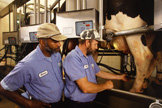
Canton, New York: December 16, 2020. Research conducted by a team of veterinarians and dairy specialists with Quality Milk Production Services, the William H. Miner Agricultural Research Institute, and Cornell Cooperative Extension evaluated how different teat end treatments impact cow health under winter conditions. Based on their findings, the researchers recommend several best management practices for dairies milking in colder temperatures. A Northern New York Agricultural Development Program grant funded the project.
A six-week mid-winter trial evaluated two types of post-milking teat dips: a powdered chlorhexidine acetate teat treatment and a foaming 1 percent iodine dip. The final dataset totaled 331 cows that were milked three times a day. The cows were housed in freestall barns bedded with sand or sawdust or in a tiestall barn with foam mattresses bedded with sawdust. All cows received pre- and post-milking dip treatments.
Teat skin chapping and thickening of the outer layer of skin on the teat ends can reduce the ability to achieve clean teat ends. This creates the opportunity for increased environmental bacterial pathogen colonization and thus increases the risk of mastitis and higher somatic cell count. The 331 cows in the study were evaluated for clinical mastitis and subclinical mastitis infections, somatic cell count, linear score, teat skin condition, and teat end score.
At the start of the trial, the percentage of udder quarter samples with a negative culture test for the powdered treatment group was 66 and for the iodine dip group, 65. At the end of the trial, the percentage of quarter samples with a negative culture test for the powdered treatment group was 79 and for the iodine dip group, 86.
While there was no difference in clinical mastitis between the two groups, the powdered treatment group showed a greater risk of new subclinical infection (odds ratio of 1.59) and had a greater risk to have a positive culture result for a minor mastitis organism (odds ratio of 1.63) or Staph. aureus infection (odds ratio of 2.32) at the end of the trial.
There was no difference in number or odds ratio for coliform or Streptococcus spp. infections. The researchers found no significant difference between the two study groups as to teat skin condition, teat end scoring, or linear scoring.
To reduce the risk of cold climate-related mastitis infections, Heather Dann, Ph.D., a research scientist with the William H. Miner Agricultural Research Institute, Chazy, N.Y., suggests the following as best management practice for dairies milking in colder temperatures and in situations where cows may be exposed to cold and windchill in the barn or going to and from the milking parlor:
- Use hygienic milking protocols
- Make sure milking equipment is properly functioning
- Continue using an effective post-milking teat dip
- Remove excessive post-milking teat dip from teat by gently blotting to reduce moisture waiting for dip to dry to prevent freezing
- Troubleshoot barn and parlor facilities to reduce opportunity for windchill
- Maintain dry and clean bedding.
The average temperature of 42 degrees Fahrenheit in the barns during the trial was moderate for a northern New York winter. The researchers emphasize that different results might have been recorded under harsher, more typical winter temperatures.To read the complete Powdered Teat Dip Post-Milking Under Cold Weather in NNY report, see the Research: Dairy Research projects tab at www.nnyagdev.org.
 Funding for the Northern New York Agricultural Development Program is supported by the New York State Legislature and administered by the New York State Department of Agriculture and Markets.
Funding for the Northern New York Agricultural Development Program is supported by the New York State Legislature and administered by the New York State Department of Agriculture and Markets.